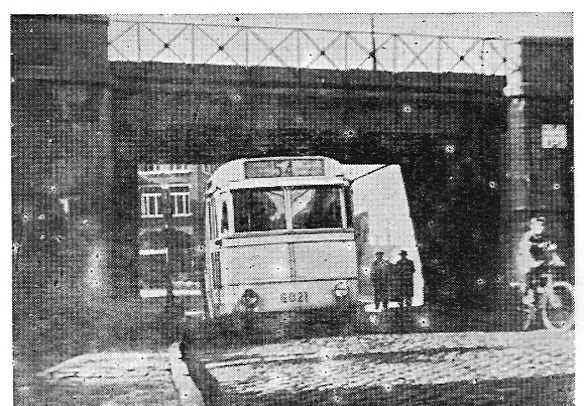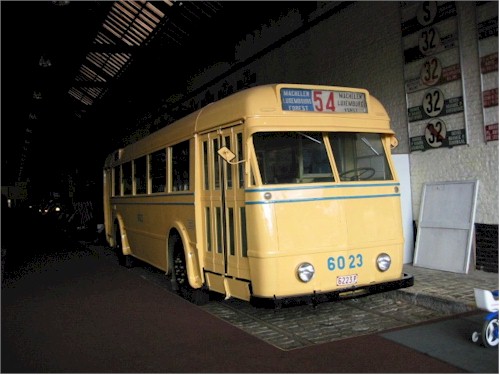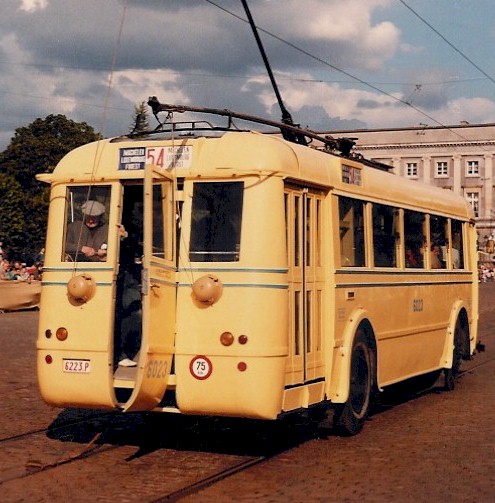
The Brussels' trolleybus : technical profile
24 vehicles
have ride in Brussels.
These were divided
in 4 different series
:
-
from 6001 to 6007, into service in 1939
-
from 6008 to 6012, into service between 1940 and 1941
-
from 6013 to 6022, into service between 1945 and 1946
-
6023 and 6024, into service in 1956 and 1957
The vehicles were built,
concerning the chassis by
Brossel,
concerning the
coachbuilding
by Paul
DíHeure,
the electrical components were made by
ACEC.
- The first serie was recognizable by the radiator in front of the vehicle and by the mudguards in front of the back wheels. The lateral destination indicators were shorter and installed over the doors.
-
On the vehicles of the second serie,
there was no more radiator and the lateral destination indicators were larger.
- The vehicles of the third serie had a more common appearance : the only lateral indicator destination was installed in the back side, over the seat of the conductor, and the mudguards were no more present.

Trolleybus 6021 rides under the old narrow bridge at Forest-Est station, between 1946 and 1949. The trolleybuses of this serie were brought into service a short time after the Second World War. On this picture we can recognize the typical appearance of the brussels trolleybus, that were adapted later on the other vehicles.
All the visible differences in all the series were little by little corrected and all trolleybuses were later homogeneous.
-
The last two vehicles were completely
built in the STIB factories, who made the entire coachbuilding work.
Technical specifications
of the trolleybus :
Length 10 metres,
width 2,35 metres,
wheelbase 4,85 metres,
compound ACEC 67/171
motor of
107 CV,
controller command to control
the speed, rheostatic service- and air
compressed brake
,
mechanic station brake.
The inner side of the
trolleybus is conform to the style of these times :
36
sitting
places
in 2 rows of 9 double seats,
practically all sitting facing forward. There was 30 stand places too. After the
Second World War and the installation of the conducteur seat, a one-way
circulation was established in the vehicles, where the clients had to take on
board through the back door and to set down through the front door.

Trolleybus 6023 in all its splendour. It was one of the last two vehicles builded in the STIB factories in the middle of the 50's. This trolleybus is conserved in the Brussels Urban Transport Museum. MTUB 3/3/2002.
It must be noticed that
the vehicle was equiped with a "carriage", an electric conductor that could fit
in a tram rail. With this carriage the trolleybus
could
follow a tram road. For
security reasons this system was not used during the service, but only when the vehicles
rode back to the garage. An agent must care that the carriage was perfectly fitted
in the rail. If this one left the rail, the vehicle lost its negative pole.
Difficult points were of course the different crossings and switchings.

The trolleybus in 'with carriage' mode : we can see that one of the poles is down and that the carriage is in the rail. The back door is open to control the perfect positioning of the carriage. Place des Palais 21/7/1985 (Picture R. Stevens)
And we won't forget that the last vehicles were equiped with accumulators, this vehicles could maneuver in different places where there was no trolley wire (for example, to turn and go back).